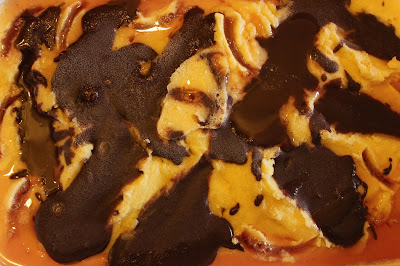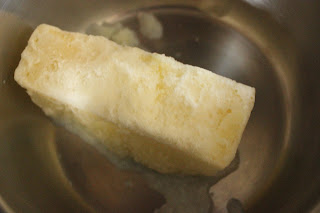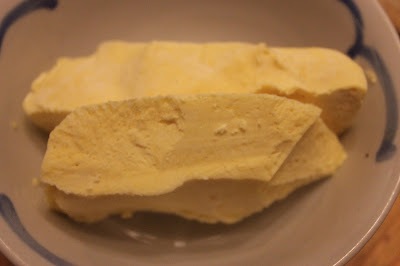All milk is not the same, even if it is raw, organic and grass-fed and when you can get the best, you want to hang on to every last drop. Although, living in France, we can get hold of raw milk easily, I've always toyed with the idea of freezing both milk and cream but this Summer, the long spell of hot weather convinced me I needed to find out how to go about it.
These Normandes are part of the herd belonging to the local organic dairy farm, where I buy grain for our chickens. We also buy their raw milk and crème fraîche, which is made in the dairy every Thursday.
A2 and A1 type diary cows
The Normandy cow is presumed to have descended from cows brought over by invading Vikings, who settled and farmed here in the tenth century. These beautiful and docile animals along with the wheaten coloured Froment du Léon, are thought to have given birth to one of the most famous A2 breeds, the Guernsey. Some 5,000 years ago a mutation occurred in the milk solids of dairy herds, in particular in the beta-casein chain of amino acids at position number 67. Cows without the mutation are known as A2 and those with the mutation, such as the Holstein race, are called A1. If you want to delve into the fascinating subject of ancient cattle breeds, amino acids, A1 & A2 milk and the implication on health then try this link as a starting point ¹.
Freezing milk as ice cream
The very best milk comes with the new grass in early Spring, so it's then I tend to make large batches of ice-cream to last us the Summer long. On the left is dark mocha chocolate and rose petal ripple, this year's invention.
Freezing milk as milk
Raw milk actually doesn't really go 'off' it just turns into something else but if you want milk for coffee or tea, then freezing seems a great option. All the books I looked at and websites I visited, informed me that milk had to be homogenised to freeze, which raw of course is not. However, I finally found the answer on the Simple Foody blog² . The answer is amazingly simple, the milk just needs to be blended prior to freezing or when it is thawing.
 All the blender does is distribute the cream more evenly but it still comes to the surface again as it freezes. However, when you heat it gently it does not come out as the 'chunky milk' you get if you freeze it without blending. Some people blend before freezing, some on defrosting, personally we have found it better to blend before.
All the blender does is distribute the cream more evenly but it still comes to the surface again as it freezes. However, when you heat it gently it does not come out as the 'chunky milk' you get if you freeze it without blending. Some people blend before freezing, some on defrosting, personally we have found it better to blend before.
To make for ease of use, we freeze it in containers and then cut it into usable slices. These can then be used directly as needed or as I do with my own eggs, I freeze in portions for recipes. So, if you live in a State or country where you can not buy raw milk but you can go across the border and bring back a large volume, this could be a great way of getting your daily elixir.
Freezing crème fraîche

The crème fraîche we get from the farm, is so thick the spoon will stand up in it and I was told I should be careful blending or whisking it as it would turn into Chantilly. If you have thinner crème fraîche, then I would think of whipping it before freezing.
Again, we froze it in containers and cut it into slices. I just left it to thaw in the open in the Kitchen
It looked no different thawed than it did when it went into the freezer.
Here I used it to accompany a foraged fruit crumble of blackberries, elderberries and bullaces.
If you live in a country where it is illegal to sell raw milk then your alternative, other than buying on-line, is to get yourself a cow-share or, as my sister did, get yourself a housecow or a couple of cows. Here they all are on my recent visit back to Scotland. Meet the very friendly, easy to handle, rare-breed and giving A2 milk; Shetlands, Marilyn and Daisy:
...and here's another of our films made on the organic farm from where we get our milk, it shows us helping to get in the cows for milking and how to make cream and butter.
RELATED ARTICLES
Rich Vanilla Ice Cream - Victorian Recipe GLUTEN FREE
The Victorians, including the Queen, had a very sweet tooth, so I've cut the amount of sugar in half. This is also because all the ingredients are organic and I find organic sugar...read more
¹
http://www.westonaprice.org/thumbs-up-reviews/devil-in-the-milk
²
http://www.simplefoody.org/freezing-raw-milk
© 2013 Sue Cross










I found this on organicpastures.com website
ReplyDeleteDoes freezing damage raw dairy products?
Freezing puts raw milk products to sleep and has little effect on the important health benefits that raw dairy products provide. Enzymes and bacteria are fully active when they awake after thawing. Some vitamins are reduced by trace amounts after being frozen. The flavor is sometimes slightly affected by this and is not always apparent. All OPDC products may be frozen. Thawing should be done by placing the frozen product in a regular refrigerator for a day. Milk should be shaken to mix up the butterfat after thawing. Warming the product to room temperature just prior to drinking will also make the fat blend in better with the milk (if it has clumped or separated during freezing). I freeze milk in 1/2 gallon plastic just after some disasters no mater what with glass. Only fill to shoulder of jug, lay on side or up right, set timer and GENTLY shake every 15 mins till about solid. Thaw in pan of cool water. In Fridge 3 days. DO not shake until milk is fully thawed. Blessings!
Hi bakerbee and thanks for sharing that information, much appreciated.
ReplyDeleteWe actually don't have a refrigerator but we just get the milk out and either leave it to thaw or for morning coffee and porridge we actually warm it slightly and very slowly on the top of the cooker. Depending on the time of year and therefore the quality of the grass, we get more butterfat hence we sometimes need to blend again when the milk thaws. As you can see, our milk comes from Normandy cows, the forerunners of the Guernsey, so very creamy but this is what make organic raw products so great - they are never the same because they are so 'alive'. Yes, re glass, we have been hoping to get some stainless containers and also a milk can because at the moment we are just fetching it from the farm in water bottles, which do get recycled but I'd rather we just had a plain metal can. We got up very early last month and went to the farm to film their 1930's century cream separator in action, it was an amazing machine and I hope to write it up soon, also hand churning the butter and some tips for that. My big resolution for next year is to make cheese, after all Normandy cows are famed for their Camembert, Brie, Liverot etc. Also we have an organic goat farm down the road and when the milking starts again I hope to have a go at goats' cheese too. If you have any tips I would be most grateful. All the very best and thanks, Sue